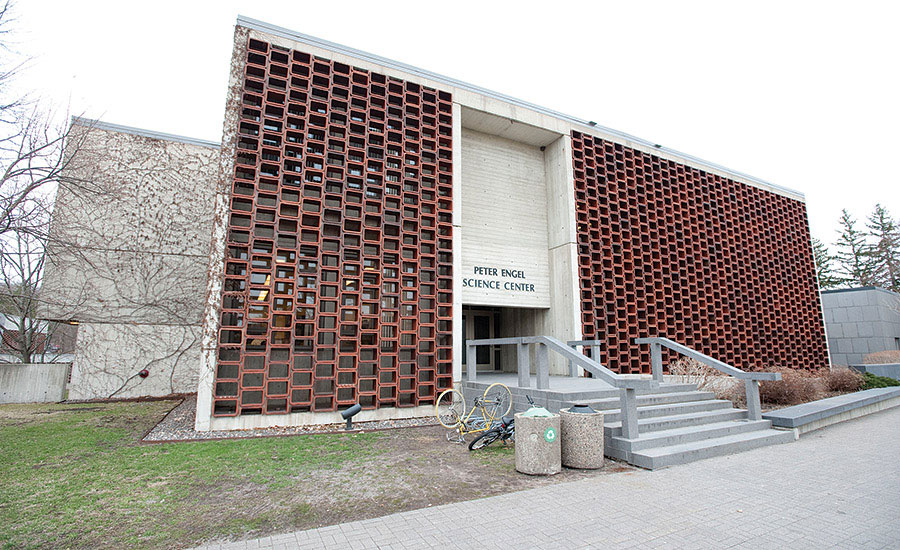Minnesota was recently put to the test when it had one of the coldest winters on record. While many commercial buildings required more energy to keep occupants comfortable, one private school in the state actually saved money. St. John’s University in the town of Collegeville undertook a heating system retrofit just before the winter season.
“We were approached by our local wholesaler, Ferguson Enterprises, with the suggestion that we consider replacing the pumps in the Peter Engel Science Center with Grundfos MAGNA3 smart circulator pumps,” said David Schlumpberger, the campus HVAC tech. “I wasn’t aware of them before, but the existing pumps were nearing the end of their lives, so we decided — why don’t we do something more efficient?”
Environmental stewardship is a core Benedictine tradition at St. John’s, which boasts an office of sustainability and sits on 2,700 acres of wetlands, lakes, and forests.
“The MAGNA3 smart technology is a really good fit for a school that teaches students a respect for the land,” Schlumpberger explains.
Schlumpberger and his team opted for the MAGNA3 circulators due in large part to the products’ electronic technology and efficiency. Its signature feature is the AUTOADAPT function, which saves energy by continuously fine‐tuning power consumption, discharge head, and flow rates to meet the dynamic needs of the system.
Laid out in four wings, the Peter Engel Science Center is used primarily during the school year, running heat from fall through spring.
“We had a feeling the old pumps were oversized, but there was no way to tell — until we did the replacement,” Schlumpberger says.
The building contains two primary circulators, pumping hot water supplied by a steam-to-hot-water convertor, with the steam coming from a central plant. There are four pumps on the secondary loops — each serving a different wing — feeding baseboard heating that uses pneumatic, three-way mixing valves to help regulate the temperatures.
Initially, Schlumpberger and his team thought the outdated pumps were on a variable flow system. “But after the pumps were installed and we started it up, we realized that the system was not variable; it was a fixed flow,” he says.
Since the building wasn’t zoned and no VFDs were installed, the entire system was operating full-bore throughout the heating season. The team performed an audit of the existing pumps and found the north wing was originally designed for 41.5 gpm at 20 ft of head; the south — 24.1 gpm at 21 ft; the east — 23.7 gpm at 21 ft; and the west — 17.4 gpm at 21 ft.
“As suspected, the engineers had oversized that older system,” says Soderholm. “Oversizing wastes energy and is hard on the pipes. In fact, we saw evidence of that in some copper piping that Dave’s staff removed. The insides of the piping were lined with ridges, indicating damage from excess velocity.”
The intelligent technology of the four new MAGNA3 aims to minimize energy costs. The pump has a built-in energy meter and a flow-limiting function. According to the company, even at reduced loads, these circulators save energy compared with conventional circulators. They’re also an all-in-one option for building owners, eliminating the need for costly installation of a companion flow meter, pressure and temperature gauges, throttling valve, constant-speed pump, or Btu meter.
“With the MAGNA3s, we were able to get the necessary flow rates at much fewer feet of head [lower pressure],” Soderholm says. “Over time, I think they’ll be able to slash their energy use even further. Even though this was not a system with variable-flow characteristics, the payback numbers are still really impressive.”
“We sized the pumps to match the old pumps, not knowing what their true system requirements were,” Soderholm says, explaining they had only the rating plates to go by, since their analysis was conducted during summer.
“Even though the Grundfos pumps are larger than necessary for this building,” he continues, “it’s not wasteful, because we were able to dial them down with impressive results.”
Now the north wing is at 39.6 gpm at 14.8 ft; the south — 25.5 gpm at 9.2 ft; the east — 21.1 gpm at 8.53 ft; and the west — 12.8 gpm at 7.2 ft.
What that translates into is an estimated yearly savings of $693.
“The bottom line is that The MAGNA3 is sophisticated and capable of doing everything the old pumps did, only better because it’s smart,” says Schlumpberger. “It can tell itself to slow down or speed up, based on current demand. Another benefit is that now we can get data off the pumps’ readout and learn more about the building’s needs.”
Schlumpberger adds: “We just had the coldest winter in 30 years and we were running pumps at 25% of the head that the old pumps had, while keeping the building warm. In other words, we’re actually able to run the system at the original designed flow rate, using less power, less energy, and at less cost.” ES





